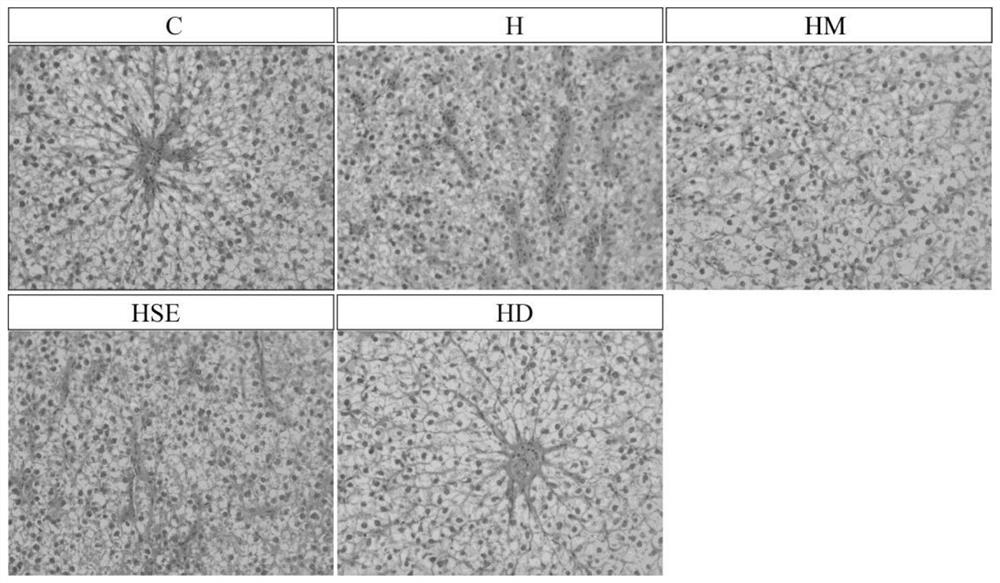Preparation for improving fish intestinal pathology injury
A intestinal and pathological technology, applied in the field of preparations for improving fish intestinal pathological damage, can solve problems such as intestinal damage in farmed fish
- Summary
- Abstract
- Description
- Claims
- Application Information
AI Technical Summary
Problems solved by technology
Method used
Image
Examples
Embodiment 1
[0033] In the experiment, white fish meal (histamine content 107.6 mg / kg) and soybean meal were used as the main protein sources to make basal feed C for peltago catfish experiment fish, and 1000 mg / kg exogenous histamine was added to basal feed C to make a diet containing Feed H with a high concentration of histamine, and fed the experimental fish with feed H for 30 days, and established the experimental fish intestinal injury model (the detailed formula composition of feed C and feed H is shown in Table 1, wherein the nutritional composition of the feed is analyzed according to GB / T- 5009 series method, the determination of histamine content is carried out according to GB / T 5009.45-2003 / 4.4 method). The evaluation method for establishing the pathological injury model of experimental fish is as follows: ≥80% of the samples (intestines) of the experimental fish in group H have obvious pathological injury and the activity of intestinal injury indicator enzymes has a significant ...
Embodiment 2
[0051] According to the experimental design of Example 1, a culture experiment was carried out for 56 days. At the end of the experiment, the fish were fasted for 1 day, and the test fish were lightly anesthetized with MS-222, and blood was drawn from the tail vein of 5 fish in each tank. The collected blood was placed in a foam box filled with ice cubes, and after being completely coagulated, it was centrifuged at 4000 g for 10 min (4°C). The prepared serum samples were temporarily stored in liquid nitrogen and stored at -80°C until analysis.
[0052] Serum biochemical indicators such as alanine aminotransferase (ALT), aspartate aminotransferase (AST) and diamine oxidase (DAO) activity were purchased from Nanjing Jiancheng Bioengineering Institute, and measured with a Thermo full-wavelength microplate reader. The effects of each feed group on the activities of serum alanine aminotransferase (ALT), aspartate aminotransferase (AST) and diamine oxidase (DAO) of experimental fish ...
Embodiment 3
[0054] According to the experimental design of Example 1, the intestinal tissue samples (5 fishes per tank) of the experimental fishes in the 56-day breeding experiment were collected and fixed in neutral formalin for 48 hours. The samples were dehydrated by alcohol gradient, transparentized in xylene, and embedded in paraffin, and sliced with a thickness of 4 μm. After the sections were dewaxed with xylene, stained with hematoxylin-eosin and mounted with neutral gum, they were observed under an optical microscope (model: OLYMPS CX31) and images were collected.
[0055] image 3 The microstructure of the intestinal tissue of the peliotus observed after HE staining. The results of microscopic observation showed that the folds of the foregut intestine tissue in group C were closely arranged, the cell structure was normal, the epithelial cells were arranged neatly, the microvilli layer was relatively neat, and the size of vacuoles on the nucleus was relatively uniform; the num...
PUM
 Login to View More
Login to View More Abstract
Description
Claims
Application Information
 Login to View More
Login to View More - R&D
- Intellectual Property
- Life Sciences
- Materials
- Tech Scout
- Unparalleled Data Quality
- Higher Quality Content
- 60% Fewer Hallucinations
Browse by: Latest US Patents, China's latest patents, Technical Efficacy Thesaurus, Application Domain, Technology Topic, Popular Technical Reports.
© 2025 PatSnap. All rights reserved.Legal|Privacy policy|Modern Slavery Act Transparency Statement|Sitemap|About US| Contact US: help@patsnap.com



